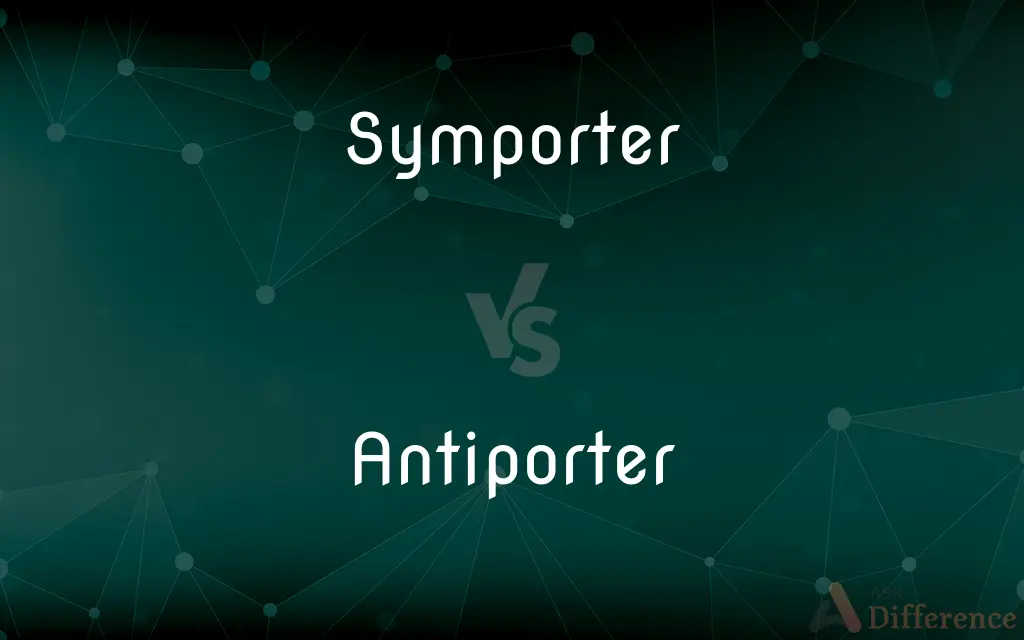Symporter vs. Antiporter — What's the Difference?
By Urooj Arif & Fiza Rafique — Updated on March 10, 2024
A symporter moves two types of molecules in the same direction across a membrane, emphasizing cooperation. An antiporter, however, transports molecules in opposite directions, highlighting a reciprocal exchange.

Difference Between Symporter and Antiporter
Table of Contents
ADVERTISEMENT
Key Differences
A symporter operates by transporting two different types of molecules or ions across a cell membrane in the same direction, either into or out of the cell. This process relies on the gradient of one of the transported substances to drive the movement of the other, typically using the energy from the movement of one molecule down its concentration gradient to move another molecule against its gradient. In contrast, an antiporter also transports two types of molecules but in opposite directions. One molecule is transported into the cell while the other is moved out, effectively exchanging one substance for another across the membrane.
Symporters play a crucial role in nutrient absorption and other cellular processes where the simultaneous movement of molecules in the same direction is beneficial. For example, in the intestine, glucose absorption by cells is facilitated by symporters that move glucose and sodium ions into the cell together. Antiporters are vital for maintaining cellular pH, ionic concentration, and other homeostatic functions by exchanging ions such as sodium for hydrogen or calcium in different cellular compartments.
The energy source for symporter and antiporter activity can vary. Symporters often utilize the energy from ion gradients established by primary active transport mechanisms, like the sodium-potassium pump, to co-transport substances against their concentration gradients. Antiporters, while also potentially utilizing ion gradients, specifically function by directly exchanging one ion or molecule for another, creating a balance in the concentrations of these substances on either side of the membrane.
Both symporters and antiporters are examples of secondary active transport, as they depend on the energy stored in ion gradients created by primary active transport. However, their mechanisms highlight the diversity of cellular strategies for transporting substances across membranes: symporters by co-transporting molecules in the same direction and antiporters by exchanging molecules in opposite directions.
The functional differences between symporters and antiporters underscore the cell’s ability to regulate the internal environment by controlling the movement of substances into and out of the cell. Each type of transporter contributes to the cell's efficiency in nutrient uptake, waste removal, and maintaining ionic and pH balance, showcasing the complexity and specificity of cellular transport mechanisms.
ADVERTISEMENT
Comparison Chart
Direction of Transport
Same direction for both molecules
Opposite directions for each molecule
Function
Co-transport of molecules
Exchange of molecules
Energy Utilization
Uses gradient of one molecule to transport another
Exchanges one molecule for another using gradients
Role in Cell
Nutrient absorption, etc.
Maintaining pH, ionic balance, etc.
Example
Glucose and sodium symporter
Sodium/hydrogen antiporter
Compare with Definitions
Symporter
A transporter that moves two molecules in the same direction across a cell membrane.
The glucose-sodium symporter facilitates glucose uptake in intestinal cells.
Antiporter
Critical for ionic homeostasis and pH regulation.
Antiporters in the plasma membrane exchange sodium for potassium.
Symporter
Utilizes the concentration gradient of one molecule to transport another.
Sodium gradient-driven symporters are essential for amino acid uptake.
Antiporter
Exchanges one ion or molecule for another to balance concentrations.
Calcium-sodium antiporters maintain cellular calcium levels.
Symporter
Integral for cellular processes requiring simultaneous movement.
The symporter mechanism is vital for renal glucose reabsorption.
Antiporter
Part of the secondary active transport system.
Antiporters contribute to the electrochemical balance necessary for nerve function.
Symporter
Enables co-transport of ions and nutrients.
Proton symporters are key in plant nutrient uptake.
Antiporter
A transporter that moves two molecules in opposite directions across a membrane.
The sodium-hydrogen antiporter helps regulate intracellular pH.
Symporter
Functions as part of secondary active transport.
Symporters leverage sodium gradients established by ATPase pumps.
Antiporter
Operates by using the gradient of one substance to move another.
The sodium gradient is used by antiporters for countertransport.
Symporter
A symporter is an integral membrane protein that is involved in the transport of two different molecules across the cell membrane in the same direction. The symporter works in the plasma membrane and molecules are transported across the cell membrane at the same time, and is, therefore, a type of cotransporter.
Antiporter
An antiporter (also called exchanger or counter-transporter) is a cotransporter and integral membrane protein involved in secondary active transport of two or more different molecules or ions across a phospholipid membrane such as the plasma membrane in opposite directions, one into the cell and one out of the cell. Na+/H+ antiporters have been reviewed.In secondary active transport, one species of solute moves along its electrochemical gradient, allowing a different species to move against its own electrochemical gradient.
Symporter
(biochemistry) An integral membrane protein involved in the movement of different molecules or ions in the same direction across a phospholipid membrane.
Antiporter
(biochemistry) A cell protein that acts within an antiport to transport different molecules or ions across the membrane in opposite directions
Common Curiosities
Can symporters and antiporters work without ATP directly?
Yes, both work without ATP directly by utilizing the energy stored in ion gradients, a process known as secondary active transport.
Can the direction of transport for symporters and antiporters change?
The direction of transport is fixed based on their mechanisms—symporters always transport molecules in the same direction, while antiporters transport molecules in opposite directions.
How do cells regulate the activity of symporters and antiporters?
Cells regulate transporter activity through various mechanisms, including phosphorylation, cellular signaling pathways, and changes in the concentration of substrates or ions that affect their gradients.
Do symporters only transport ions?
No, symporters can transport a variety of molecules, including ions, glucose, amino acids, and other nutrients.
Are antiporters found in specific cell types?
Antiporters are found in many types of cells, as they play essential roles in maintaining cellular homeostasis across different organisms.
Are there diseases associated with malfunctioning symporters or antiporters?
Yes, malfunctions in these transporters can lead to diseases, such as cystinuria due to defective amino acid symporters or various electrolyte imbalances due to antiporter defects.
Can one molecule be transported by both a symporter and an antiporter?
Yes, depending on the cell’s needs and the specific pathways involved, a molecule like sodium could be transported by both symporters and antiporters at different times or locations.
How are symporters and antiporters similar to pumps?
While they all transport molecules across membranes, pumps often require direct ATP hydrolysis (primary active transport), whereas symporters and antiporters utilize existing ion gradients (secondary active transport).
How do symporters and antiporters affect drug absorption and distribution?
These transporters can significantly affect drug pharmacokinetics by influencing drug absorption, distribution, and elimination in the body, making them important considerations in drug design and therapy.
Can symporters and antiporters work together in a cell?
Yes, symporters and antiporters often work together within a cell to ensure efficient transport and balance of substances, contributing to the overall homeostasis.
Share Your Discovery

Previous Comparison
Elasticity vs. Spandex
Next Comparison
Elegy vs. DirgeAuthor Spotlight
Written by
Urooj ArifUrooj is a skilled content writer at Ask Difference, known for her exceptional ability to simplify complex topics into engaging and informative content. With a passion for research and a flair for clear, concise writing, she consistently delivers articles that resonate with our diverse audience.
Co-written by
Fiza RafiqueFiza Rafique is a skilled content writer at AskDifference.com, where she meticulously refines and enhances written pieces. Drawing from her vast editorial expertise, Fiza ensures clarity, accuracy, and precision in every article. Passionate about language, she continually seeks to elevate the quality of content for readers worldwide.














































